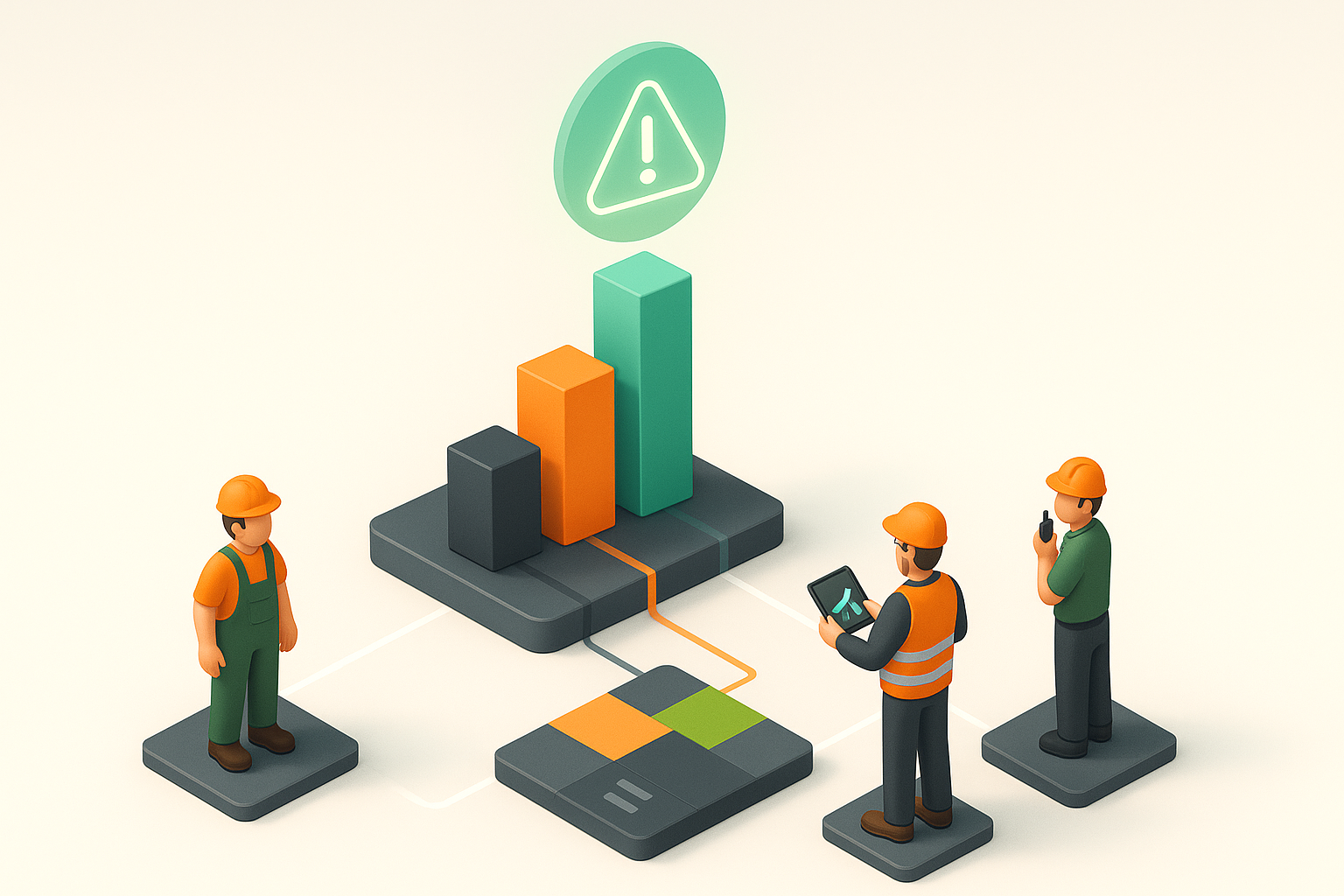
People make a business run, but not every company knows how many people it will need next month, next year, or during a sudden surge in demand. That’s where the idea of workforce planning begins to matter. At its core, it helps you understand who you already have, who you’ll need later, and how to prepare for both without scrambling at the last minute.
So, what is workforce planning in practical terms? It’s a structured way of matching staffing with real business needs — not just today’s tasks, but the direction your company is actually moving toward. Some describe it as forecasting; others call it strategy. In reality, it’s a blend of both. It uses data, patterns, and experience to make sure you have the right people in the right roles when it counts.
At its simplest, workforce planning is the practice of figuring out who your organization needs — and when. It connects everyday staffing decisions with long-term priorities, so hiring, scheduling, and training aren’t just reactions to whatever goes wrong next week. The whole point is to bring some clarity to the chaos that often surrounds workforce decisions, especially as companies grow or shift direction.
A formal workforce planning definition usually talks about balancing talent supply with business demand. But in real work, it’s a little more down-to-earth. It’s the process of looking at your current team, the skills they have, the gaps you’ll face soon, and the steps needed to stay ready for that future.
Some companies treat it as a forecast; others see it as part of strategy. The truth lands somewhere in between. Good planning blends headcount numbers with practical knowledge — who’s close to moving roles, who’ll retire soon, which projects will require new expertise, and how fast the company is expected to grow. That mix of data and intuition is what keeps the whole workforce planning process from becoming guesswork.
Workforce management handles the day-to-day: schedules, shifts, timesheets, the immediate needs of keeping people in the right place. Workforce planning zooms out. It asks bigger, slower questions — the kind you can’t answer with a weekly schedule.
What is workforce planning compared to management? Planning looks ahead. Management keeps things moving today. Planning asks what the team should look like next year; management makes sure everyone shows up tomorrow. Businesses need both, but when planning is missing, even the best operational tools turn into a temporary fix.

Businesses move in waves — busy seasons, quiet months, unexpected spikes that come out of nowhere. Without some kind of preparation, teams end up stretched thin during the peaks and underused during the dips. Workforce planning brings balance to that cycle. It helps leaders see ahead a little sooner and act before small problems start stacking up into bigger ones.
If you’ve ever had to hire in a hurry, you already know why workforce planning benefits matter. When companies don’t look ahead, they scramble. When they do, hiring becomes calmer, training feels intentional, and overtime stops ballooning out of nowhere.
A big part of why workforce planning is important is the timing. Planning doesn’t eliminate uncertainty, but it softens it. You notice patterns earlier — a department that’s slowly outgrowing its capacity, a skill gap that’s about to become critical, a team at risk of burnout. Those early signals give you space to act before the pressure hits.
Even the strongest teams fall out of sync when hiring and strategy pull in different directions. Workforce planning ties them back together. It forces the organization to ask the right questions: What are we trying to achieve? What kind of work will that require? Do we have the people who can take us there — and if not, how long will it take to find or train them?
This is where workforce planning and analytics really help. Data shows what’s actually happening instead of what everyone assumes. You might learn that a team thought to be “fully staffed” is covering two roles each, or that a planned expansion will require twice as many specialists as expected. Strategy becomes clearer when the people part is no longer a guess.

Most companies think they’re planning ahead when they create next quarter’s hiring list or decide how many people each team should keep on rotation. But strategic workforce planning looks much further than that. It examines long-term shifts — in technology, markets, customer behavior, even regional talent availability — and helps the business prepare before those changes show up on the surface. Strategic planning isn’t a spreadsheet exercise. It’s a mindset that treats people as a core part of the company’s future, not just a resource to fill seats today.
When done well, it turns staffing from a reactive chore into a quiet, ongoing process that keeps teams ready for growth, restructuring, or unexpected dips. Companies that rely on it don’t wait for a crisis to realize their talent pipeline is too shallow or a key skill is missing. They see those gaps forming early, often months or years before the impact becomes painful.
So, what is strategic workforce planning? It’s long-term forecasting brought into the real world. Instead of guessing, leaders use data, industry trends, and internal knowledge to understand which roles will matter tomorrow — not just the ones that matter today. Some changes are predictable, like retirements or new service lines. Others show up unexpectedly: a new type of project, a shift in customer expectations, a technology adoption curve that suddenly accelerates.
A well-planned pipeline also reduces turnover. When employees see room to grow — and feel the company actively invests in developing them — they’re far less likely to leave. Strategic planning, in that sense, supports retention as much as it supports growth.
Growth is rarely linear. Some years bring rapid expansion; others feel like holding steady is the biggest win in the world. Strategic planning helps leadership anticipate both scenarios instead of reacting to whichever one arrives. It connects staffing with the company’s roadmap, so when new contracts, markets, or product lines appear, the team already has the people — or the plan — to handle them.
This approach also helps avoid the common “boom-and-burnout” cycle. Without a long-term view, companies hire aggressively during busy seasons and then cut back just as drastically when demand shifts. Strategic planning levels the curve. It makes growth sustainable instead of frantic. Analytics play a part here too. By observing hiring patterns, team performance, and capacity trends, companies can catch early warning signs: rising overtime, skill shortages, slower project delivery. Fixing these issues upstream supports healthier expansion in the long run.
When strategic workforce planning is a regular habit rather than an annual task, the business becomes steadier — and a lot more resilient when the market changes direction.

The workforce planning process usually starts with a simple question: do we have the people needed for the work ahead? To answer it honestly, companies look at their current teams — skills, capacity, bottlenecks, and the areas where work tends to pile up. This early snapshot shapes everything that follows, because it shows what’s stable, what’s fragile, and where change is already overdue.
After the groundwork is clear, planning shifts into practical steps. Leaders decide whether they need to hire, retrain, reorganize roles, or adjust how workloads move through the team. These changes rarely happen all at once. They unfold gradually, and each adjustment helps the next one make more sense. The goal isn’t to redesign the whole structure overnight but to steer it in the direction the business is actually moving.
The last stage is ongoing evaluation. Plans only stay useful if they stay accurate, so companies review performance data, turnover patterns, and upcoming projects to see whether their assumptions still match reality. When something shifts — even slightly — the plan shifts with it. That’s what keeps the process steady and prevents unpleasant surprises later on.
Different organizations approach planning in their own way, usually shaped by how their work behaves over time. Some rely on workforce planning models that flow from leadership’s long-term goals and build staffing around those intentions. Others let the signal come from the ground — managers who notice workload shifts long before anyone else does. Neither path is flawless, and most companies end up mixing both simply because day-to-day reality rarely fits neatly into one method.
There’s also the habit of preparing for several outcomes instead of locking into a single prediction. A company might sketch out what staffing looks like during a year of steady growth, but they’ll also think about a slower season, or the sudden jump in demand that sometimes shows up without warning. Scenario planning isn’t a guarantee, yet it softens the impact of change. When the situation shifts, the team already has a rough map rather than a blank page.
Some teams go deeper into data. They watch how work actually moves: which months get heavier, which roles slow things down when they’re understaffed, where small inefficiencies turn into real bottlenecks. These insights aren’t there to impress anyone — they simply help leaders decide whether they need new hires, extra training, or a structural tweak that keeps the workload flowing a little cleaner. No single model captures everything, but together they offer a more grounded picture of staffing needs.
When companies plan their staffing instead of reacting to every shift in demand, the workflow changes noticeably. Work stops piling up unpredictably, hiring becomes more deliberate, и teams aren’t constantly stretched thin. One of the clearest workforce planning benefits is the sense of stability it creates — not by slowing the business down, but by making the busy periods less chaotic and the quiet ones more productive.
Good planning also cuts down on waste. When leaders know which roles are truly essential and which skills will matter in a few months, they avoid overstaffing or last-minute scrambling. Hiring gets sharper, training becomes more targeted, and budget decisions feel less like educated guesses. Even small insights — a recurring skill gap, a seasonal workload spike — add up to more predictable operations.
And there’s a human side to it. Employees work better when expectations are clear and workloads don’t shift wildly from week to week. When teams see that the organization is prepared for the future, they feel more secure in their own roles. That confidence carries into performance, collaboration, and long-term retention — benefits that quietly shape the company’s culture as much as its results.
When staffing matches the actual flow of work, everything moves with less friction. Teams aren’t juggling too many tasks at once, and managers aren’t searching for extra hands at the last minute. Even simple adjustments — shifting a role, adding a skill, rebalancing one department — can lift productivity because the work lands where it should, not wherever there’s a free moment.
Some of the biggest improvements come from spotting the gaps that slowly build up over time. A few people end up taking on more than they should, while others wait for tasks that never reach them. Projects stall for reasons that aren’t dramatic — the right person was busy, the timing was off, the workload wasn’t spread out cleanly. With better visibility, these patterns become obvious enough to fix before they slow everything else down.
And once the pressure evens out, teams usually speed up on their own. Not because anyone works harder, but because they’re not constantly switching tasks or recovering from missed handoffs. The work settles into a steadier rhythm. People have the space to do their jobs properly, instead of rushing through them just to stay afloat.
Most teams rely on instinct more than they admit, and it works — at least until the workload shifts or a project slows down for reasons no one can pinpoint. Analytics fills in those blind spots. It shows how long tasks actually take, where small delays gather, and which roles quietly carry most of the load. Sometimes the numbers confirm what everyone suspected; sometimes they reveal something that wasn’t on anyone’s radar. Either way, leaders gain a clearer view before small issues turn into something heavier.
Data doesn’t hand out solutions, but it gives shape to decisions. A recurring overtime spike or a sudden dip in capacity becomes easier to read when there’s evidence behind it. From there, managers can pick a path: hire earlier, adjust shifts, spread responsibilities, or add training where it clearly matters. These choices often look modest on paper, yet they smooth out the workflow and help planning stay closer to real conditions instead of assumptions.
People tend to stay where the work feels sustainable and where the company shows that it’s thinking ahead. Planning supports this in small, practical ways: predictable workloads, clearer expectations, and fewer last-minute surprises that leave teams scrambling. When employees see that their roles aren’t constantly shifting to cover gaps, it’s easier for them to focus and take ownership of their tasks. That stability alone changes how people show up every day — with more attention, more patience, and far less of the quiet stress that builds up when staffing is inconsistent.

Even the most careful plan starts slipping if it lives only in spreadsheets or someone’s memory. Modern workforce planning tools prevent that drift by pulling data into one place and updating it as conditions change. They show how workload shifts, which skills are becoming scarce, and where small bottlenecks begin to form. The tools don’t replace judgment, but they keep the facts visible so decisions aren’t made purely on instinct — especially when the business moves faster than expected.
Different platforms offer different interfaces, but many of the essentials repeat. You’ll see forecasting modules, skill inventories, availability tracking, and alerts when staffing levels start to fall out of alignment. Some display this through dashboards; others through automatic reports. The point isn’t the format — it’s having everything in one place so leaders don’t chase information across emails and scattered files. It saves time and prevents those quiet, familiar mistakes that happen when a team outgrows manual coordination.
Forecasting turns shaky when it relies too much on gut feeling. Workforce planning analytics reveal trends that managers often sense but can’t quantify: seasonal workload spikes, recurring overtime patterns, skills that consistently run short. With that information, forecasts get sharper. They start reflecting what actually happens inside the team rather than what everyone hoped would happen. Even small insights — a role that’s overloaded every Thursday or a project that always stretches longer — help leaders adjust before pressure builds.
When information sits in separate tools, managers see only pieces of reality. An integrated workforce planning system brings those pieces together — staffing, skills, capacity, forecasts, training history — and shows how they interact. It’s easier to notice when a future project will strain the team or when a hiring plan is drifting off course. Decisions come faster because they’re based on a complete view, not fragments. And as the business shifts, the plan stays closer to what’s actually happening on the ground.
Planning becomes heavier than it needs to be when every update lives in a spreadsheet or depends on someone remembering to pass it along. A more connected setup changes that. With a tool like Planado, schedules, forecasts, and field updates sit in one place, and the picture refreshes as soon as something shifts. It doesn’t replace your judgment — it just removes the noise around it. When the routine work stops eating your time, you can focus on decisions that actually move the team forward.
What Are the Challenges in the Workforce Planning Process and How to Overcome Them?

Many issues inside the workforce planning process appear quietly, long before anyone calls them a problem. A plan may look stable on paper yet drift off course after a few busy weeks, simply because the business moved in a slightly different direction than expected. Sometimes the information is incomplete, or it lives in separate tools that no one checks at the same moment. Managers end up stitching pieces together and hoping the picture is close enough to reality. When the facts are scattered, the plan tends to lose its footing.
Some challenges come from people rather than data. Updates ask teams to adjust routines, share information more regularly, or rethink schedules they’ve used for years. These shifts aren’t heavy, but they do interrupt familiar patterns, and that alone creates hesitation. Clarity helps — showing why the changes matter and how they smooth out the workload instead of adding pressure. As soon as people notice fewer surprises in their week and a steadier rhythm, the resistance usually fades on its own.
The last obstacle is time. Planning competes with everything else managers juggle, so it gets postponed until the next quiet moment — a moment that rarely arrives. One fix is to lighten the process rather than expand it: shorter check-ins, smaller updates, and more frequent revisions. Small adjustments keep the plan aligned with what’s actually happening, and they prevent the rush that comes when problems stay hidden for too long.
Field work rarely goes exactly as planned. Crews run into delays, a job takes longer than expected, or someone finishes early and is suddenly free for another assignment. Planado keeps all these moving parts visible. Tasks update in real time, and managers see the actual progress — photos, notes, checklists, time spent — not just a status changed at the end of the day. When plans shift, the system adjusts with them, so the next decision doesn’t rely on guesswork or outdated information.
The mobile app gives technicians clear instructions without drowning them in details. They open a task and see everything they need: the client’s address, the checklist for the job, attached files, comments from the office, and the materials they’re expected to use. Once they’re on-site, every action leaves a trace — start time, photos, completed steps, signatures if needed. This stream of small but reliable updates helps planners understand how work truly unfolds, not how it looked on a schedule made earlier in the week.
Planado also helps spot patterns that normally hide in daily routines. Jobs that consistently run long, crews that handle certain tasks faster, locations where delays appear again and again. Because information from the field arrives without delay, these patterns show up naturally — and early enough to act on them. Managers can shift workloads, adjust training, or distribute tasks more evenly before an issue grows into something harder to fix. For field teams, that kind of visibility changes more than the plan; it changes how confidently everyone works.
At its core, workforce planning is a way for companies to stay ahead of the work instead of being pushed around by it. When teams know what skills they’ll need, how workload shifts through the year, and where small gaps start to form, decisions become steadier. The plan doesn’t have to be perfect — it just needs to stay close to reality. Tools help with that, but the real value comes from seeing people, data, and daily tasks as one connected system rather than a set of isolated problems.
If you’re curious how this looks in practice, Planado offers a straightforward entry point. It helps field teams share updates without delays, gives managers a clearer view of what’s happening on the ground, and keeps planning from drifting off course as conditions change. You can explore how Planado supports scheduling, forecasting, and real-time coordination — and see how much smoother planning becomes when the information finally fits together.
How do workforce planning tools and software improve forecasting accuracy? These tools make forecasts clearer by showing how work actually moves through the team — not just how it looks on a schedule. Patterns become easier to spot, which helps managers adjust sooner. With reliable data, predictions feel less like guessing and more like reading what’s already unfolding.
How can automation simplify the workforce planning process? Automation removes the small tasks that usually slow planning down — updating schedules, collecting field data, checking availability. When those pieces update themselves, the workforce planning process becomes lighter and easier to keep current. Managers focus on decisions instead of maintenance.
How does a workforce planning system help with long-term strategy? An integrated workforce planning system shows how skills, workload, and capacity shift over time, which makes long-term planning steadier. Leaders can see which roles will matter months from now and which gaps are forming early. That kind of visibility makes strategy less reactive.
Is workforce planning only relevant for large companies? Not at all. Smaller teams often feel the benefits sooner because every shift in workload hits harder. With the right workforce planning solutions, even a small business can manage hiring, training, and schedules with more confidence — and avoid the chaos of last-minute decisions.
